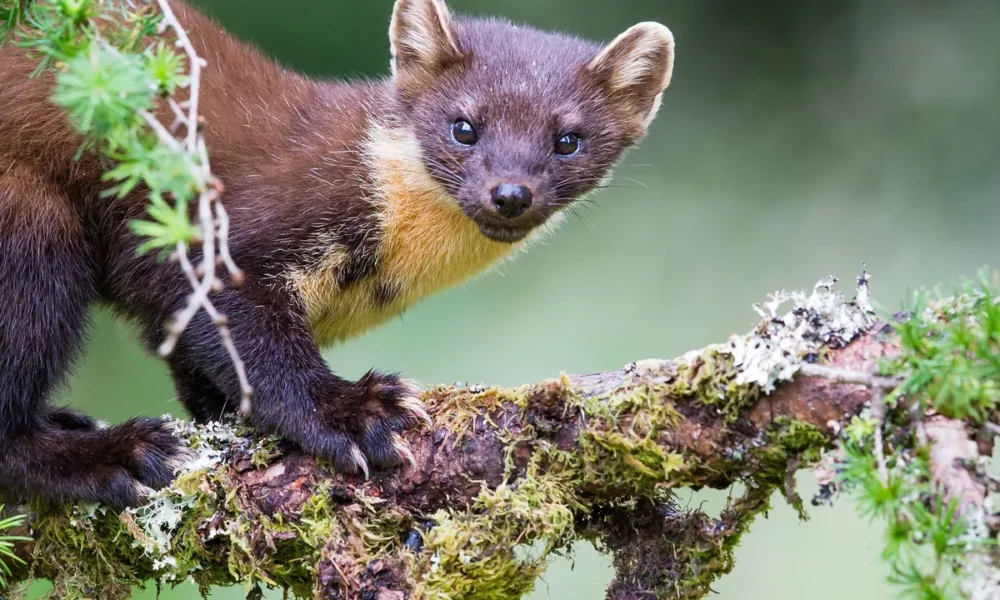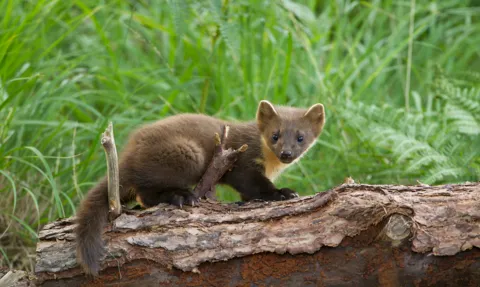For centuries, human activity reshaped landscapes, disrupted ecosystems, and pushed countless species to the brink of extinction. Yet, amidst the environmental challenges of our time, there are also stories of resilience, renewal, and hope. Across Europe, particularly in the United Kingdom and parts of the continent, three species—the beaver, the pine marten, and the water vole—are making a remarkable return. These creatures once struggled against habitat destruction, hunting, and pollution. Today, through a combination of conservation efforts, community involvement, and changing environmental policies, they are finding their way back into rivers, woodlands, and meadows.
This comeback is not merely about the survival of individual animals. It’s a story about the rebirth of ecosystems, the healing of rivers and forests, and the human realization that coexistence with nature is not only possible but essential for our collective future. Let’s journey into the fascinating world of beavers, pine martens, and voles, exploring how they disappeared, what brought them back, and why their revival is such a powerful symbol of hope.
Table of contents
- The Beaver: Nature’s Engineer Returns
- The Pine Marten: A Secretive Predator Reclaims the Woods
- The Water Vole: Rescuing Ratty from Extinction
- Why Their Comebacks Matter Collectively
- Human Involvement: From Conflict to Collaboration
- A Symbol of Hope in an Age of Crisis
- Looking Ahead: The Future of Wildlife Comebacks
- Conclusion
The Beaver: Nature’s Engineer Returns
Few animals shape the land as dramatically as the beaver. Known as “nature’s engineers,” beavers once thrived in rivers and wetlands across Europe. Their dams slowed water flow, created ponds, and nourished entire ecosystems. Birds, fish, insects, amphibians, and plants benefited from the watery havens they built.
But centuries of hunting for their fur, meat, and castoreum (a glandular secretion prized in perfumes and medicines) decimated their numbers. By the 16th century, beavers had been driven to extinction in Britain, and across Europe, only small, scattered populations remained.
The tide began to turn in the late 20th century. Reintroduction programs, starting in Scandinavia, France, and later Scotland and England, allowed beavers to re-establish themselves. In Scotland’s Knapdale Forest, a trial reintroduction in 2009 paved the way for beavers to be legally protected. More recently, projects along the River Otter in Devon and the Tay in Scotland proved that these industrious creatures could thrive once again.
Why Beavers Matter
- Flood Management: By building dams, beavers reduce flooding risks downstream. Their ponds absorb heavy rainfall, slowing surges that would otherwise overwhelm rivers.
- Biodiversity Boost: Beaver wetlands create habitats for dragonflies, herons, kingfishers, otters, and even rare amphibians.
- Water Purification: Beaver-created wetlands trap sediment and pollutants, improving water quality.
- Carbon Storage: Wetlands are powerful carbon sinks, helping combat climate change.
Beavers are not without controversy. Some farmers worry about crop flooding or damage to trees. Yet, with management strategies such as controlled releases, compensation schemes, and protective fencing, coexistence is proving possible. More importantly, communities are discovering that welcoming beavers can actually reduce long-term costs associated with flood defenses and water management.
The Pine Marten: A Secretive Predator Reclaims the Woods
Where the beaver transforms rivers, the pine marten weaves balance back into woodlands. Sleek, chestnut-brown, and agile, this member of the weasel family once roamed forests across the UK and Ireland. Yet, by the late 1800s, pine martens were nearly exterminated. Hunting for their fur, habitat destruction through deforestation, and persecution by gamekeepers who saw them as threats to poultry all pushed them into tiny refuges, mainly in the Scottish Highlands.

Their revival began slowly. Legal protection in the 1980s allowed surviving populations to recover. By the 21st century, pine martens were expanding beyond the Highlands, moving south into the central belt of Scotland, and even crossing into parts of northern England and Wales.
Why Pine Martens Are Vital
One of the most fascinating aspects of their return is the ripple effect they have on other species. Pine martens, being opportunistic predators, feed on small mammals, birds, and insects. But ecologists discovered an unexpected role: pine martens help control the invasive grey squirrel population.
Grey squirrels, introduced from North America, have long outcompeted native red squirrels in Britain. However, grey squirrels are slower and less agile than reds, making them more vulnerable to pine martens. In areas where pine martens have returned, red squirrels are bouncing back—thriving in numbers not seen for decades. This “predator-prey balance” showcases how reintroducing a top predator can restore entire ecosystems.
The Water Vole: Rescuing Ratty from Extinction
To many readers, the water vole is best known as “Ratty” from The Wind in the Willows, Kenneth Grahame’s beloved novel. Once abundant along Britain’s rivers and ditches, water voles were a familiar sight. Yet, by the late 20th century, they had suffered one of the most dramatic declines of any mammal in the UK.
The reasons were twofold: habitat destruction and the invasive American mink. Water voles rely on lush riverbanks for burrows and food, but agricultural practices and urban development destroyed many wetlands. Meanwhile, American mink, escaped or released from fur farms, proved deadly predators. Unlike native otters, mink can easily squeeze into vole burrows and decimate entire colonies.
By the 1990s, water vole populations had plummeted by over 90%. Conservationists recognized this as an urgent crisis. Efforts to restore riverbanks, control mink populations, and reintroduce voles to suitable habitats began to turn the tide.
Why Water Voles Are Important
- Ecosystem Engineers: Their burrowing and grazing shape riverbanks, creating habitats for other wildlife.
- Indicator Species: Healthy water vole populations signal clean, functioning waterways.
- Cultural Icon: Beyond ecology, Ratty holds a special place in British cultural heritage, symbolizing a harmonious riverside life.
Today, projects like those led by the Wildlife Trusts are re-establishing vole populations across counties such as Kent, Hampshire, and Cumbria. Slowly but surely, the cheerful squeak of water voles is returning to riversides where they had vanished for generations.
Why Their Comebacks Matter Collectively
Each of these species tells its own tale of loss and revival, but together, they highlight a broader story: rewilding works.
- Beavers bring water back to landscapes in natural, sustainable ways.
- Pine martens restore balance by keeping invasive species in check.
- Water voles revive riverside ecosystems and reconnect communities with cultural heritage.
Their comebacks demonstrate that with patience, science, and cooperation, ecosystems can heal. They also remind us of the interconnectedness of life. When one species thrives, it often creates conditions for countless others to flourish.
Human Involvement: From Conflict to Collaboration
Of course, the return of these animals has not been without challenges. Farmers worry about beavers flooding land. Poultry keepers fear pine martens raiding coops. Anglers express concerns about water vole burrows weakening riverbanks.

But conservationists argue that most of these conflicts can be managed. For example:
- Beaver dams can be monitored and adjusted where necessary.
- Pine martens rarely attack domestic animals if coops are secured.
- Strengthening riverbanks with natural vegetation helps reduce erosion.
Crucially, local communities are being involved in decision-making. Citizen science programs, guided walks, and education projects are helping people see these animals as allies rather than threats. In Scotland, for instance, eco-tourism around beavers now brings significant revenue to rural areas. Visitors travel from around the world to see beaver dams and ponds—a sight that would have been impossible just a few decades ago.
A Symbol of Hope in an Age of Crisis
We live in a time when climate change, deforestation, and biodiversity loss dominate headlines. Stories of extinction are tragically common. Yet, the return of beavers, pine martens, and water voles offers a counterpoint. They show us that decline is not inevitable. With effort, political will, and public support, damaged ecosystems can recover.
It’s also a reminder that conservation is not just about saving “charismatic” species like tigers or elephants. Sometimes, the small, humble creatures—the voles nibbling by the riverbank, the martens slipping through twilight woods, the beavers gnawing at willows—hold the keys to ecological renewal.
Looking Ahead: The Future of Wildlife Comebacks
The success stories of these three species are inspiring, but they also raise bigger questions about the future of rewilding. Could lynx return to Scotland to control deer populations? Might wolves, once again, roam the wilder parts of Europe? Should humans actively accelerate these reintroductions, or simply step back and let nature take its course?
There is no single answer. Each case requires careful planning, community consultation, and scientific monitoring. But the momentum is building. Across Europe, “rewilding corridors” are being created—vast networks of connected habitats that allow species to move and thrive. The hope is that future generations will inherit landscapes alive with the hum, buzz, and call of diverse wildlife.
Conclusion
The speedy return of beavers, pine martens, and water voles is more than a conservation triumph. It’s a story of resilience—both of nature and of the human spirit. These creatures were once written off as gone forever, confined to the pages of history or children’s books. Yet today, they are carving lodges in rivers, slipping through woodlands, and squeaking along banksides once again.
Their comeback is a reminder that while humans have the power to destroy, we also have the power to restore. By choosing to protect, reintroduce, and coexist, we give nature the space to heal—and in return, we find healthier, more resilient ecosystems that benefit us all.
The beaver’s dam, the pine marten’s leap, and the water vole’s squeak are not just the sounds of animals reclaiming their homes. They are the sounds of hope, of balance restored, and of a future where people and wildlife share the land in harmony.
